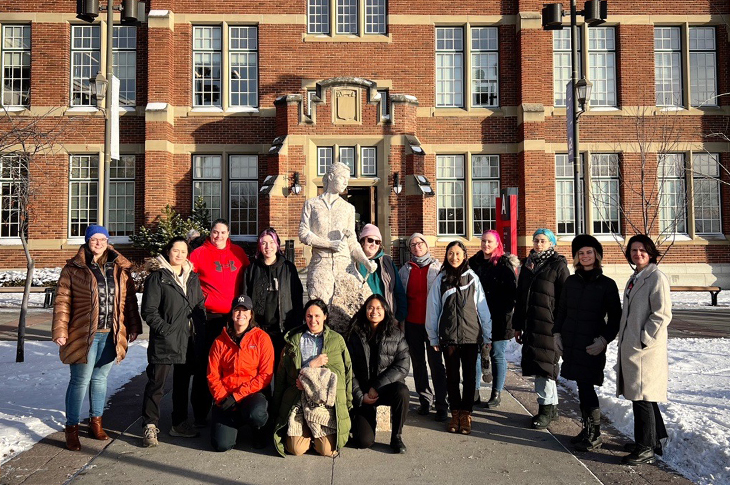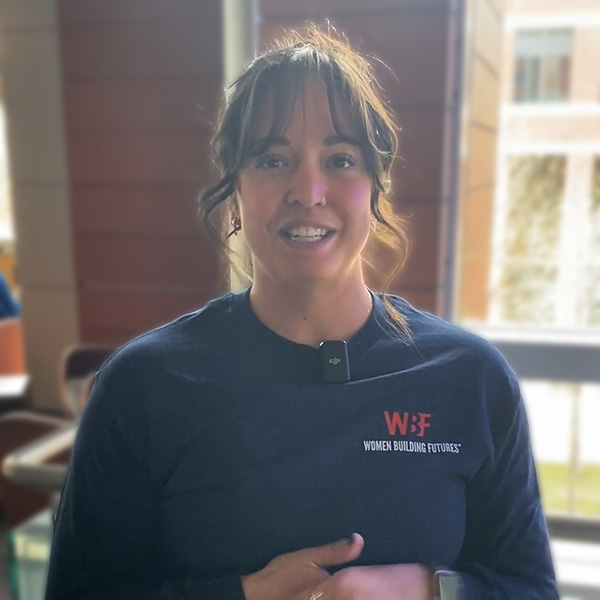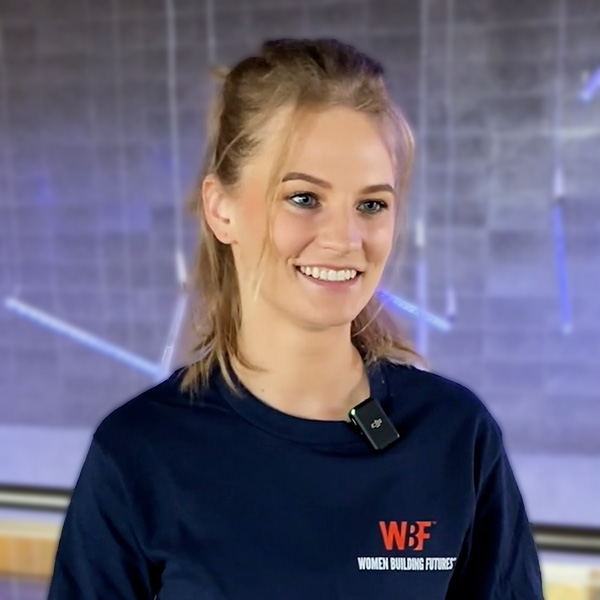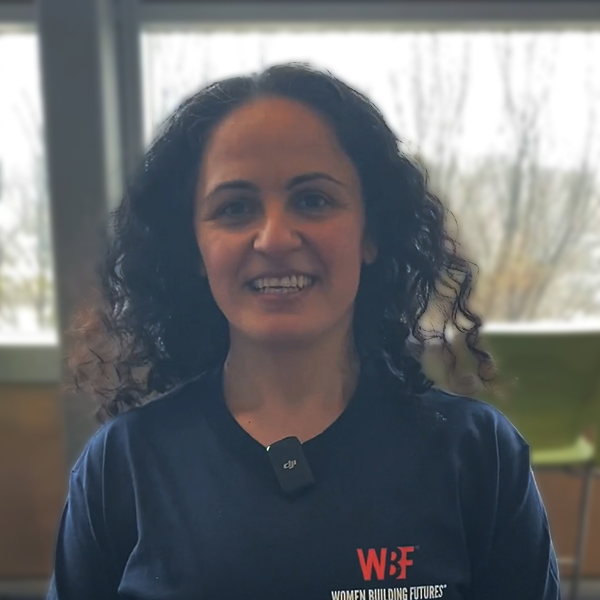Q&A with women kickstarting their journey to the trades at SAIT

For anyone who’s ever considered making a career switch, each step can be exciting, and also filled with the unknown. But carving a new path is worth it — just ask these 13 women who came to SAIT with Women Building Futures and graduated with new skills and career opportunities in trades.
Women Building Futures’ Journey to Trades is a 17-week introductory program that prepares women with the hands-on skills, safety certifications and experience to start a career in the construction trades. Areas of focus include: welding, carpentry, electrical, plumbing, millwright and steamfitter/pipefitter. Students learn a wide variety of skills in addition to technical training, including everything from practical science and math, safety awareness, financial literacy and employment skills.
“The trades are a great career choice and, as inclusion and diversity remain top priorities for companies, it’s great to see these women forging paths into a traditionally male-dominated workforce,” says Lauren Bishop, Manager, Business Development, Corporate Training Solutions at SAIT.
One of this term’s Women Building Futures participants, Darby Maglione, noted the strong connections she found. “To see how all these trades work together and the community, that was a really big draw for a lot of us. They’re a family. You can find that sense of community in every trade and every industry.”
Hear about the program from three women who started building their own success.
Q&A: Darby Maglione
What brought you to the program?
I found Women Building Futures when looking for a more stable career. I wanted to set myself up for a life where I didn’t have to worry about where that next paycheck had to go. This seemed like the perfect program to get my foot in the door.
Can you tell me about a highlight from your experience?
We got to go visit a natural gas plant north of Calgary. That was probably one of the most culture shock moments. You’d never think you’d step foot into a place like that unless you’re in the industry. For them to bring us on and show us the ins and outs — I didn’t even know what I was looking at, I’m going to be honest — but just to see how all these trades work together and the community, that was a really big draw for a lot of us. They’re a family.
You can find that sense of community in every trade and every industry.
What skills did you learn in the program?
What didn’t we learn!? We did a lot of woodworking, which is such a useful skill. I now feel confident to take apart a sink or change out a light switch — like very tangible, real-life application skills — as well as welding and pipe-fitting, which is really cool to say I’ve tried.
What’s next?
Work. I’m so ready, I’m eager. I’ve been ready to get the ball rolling for the last four weeks of the program. I’m looking forward to getting to prove myself and kick some butt.
Do you have any words of encouragement for anyone considering applying?
I mean, it’s scary, there’s no denying that, but just do it. You’re capable of so much more than you think you are, and it’s so inspiring to be surrounded by people who are also scared, but they’re just going to try it. Check it off the list, if nothing else. It’s never a waste of time.
I'm looking forward to getting to prove myself and kick some butt.
Q&A: Téa Garant
What brought you to the program?
I applied to this program because I was looking to get into electrical and had considered applying for the pre-employment electrical program here at SAIT, but it was waitlisted. I also wasn’t really sure how I was going to afford being in school. I live on my own after moving out here from Ontario.
Then one of my friends told me about Women Building Futures. I looked it up and I saw they go through welding, electrical, carpentry — all these options — and it would be fully funded. I was like, “Perfect. Let’s go.”
What was a highlight from your program?
One of my top highlights are some of the relationships I’ve been able to build while in the program. And knowing from the Women Building Futures staff how much support we have access to, to enter the workplace.
It’s not just learning and getting the experience. They’re able to help transition you into finding employment because they have employers they work with. That’s a big highlight for me.
What's next for you after today? Where do you go?
Ideally, I would like to acquire an electrician apprenticeship. I’m already registered as an apprentice. Next week, the applications open for school, so I’m going to be immediately applying so I’m set up for next year. But I need to find an employer to gain the work experience, and hopefully I have a really good mentor that will be able to teach me a lot.
I’m also very excited to go to school, do more math and learn the physics behind energy. I like math a lot. That was shocking news. It’s like a puzzle to solve.
Is there anything else that you would want to tell us or future possible WBF grads about this program or your time here?
Don’t let people make you feel like you can't do it just because you’re feminine. You can still be feminine and get the work done.
You’re strong, you’re smart and you can do it if that’s what you want to do.You're strong, you're smart and you can do it if that's what you want to do.
Q&A: Maryon Markos
What brought you to the program?
Before I joined Women Building Futures, I was a stay-at-home mom, and I really wanted to get out there and start making money. I am a people person. I love working with my hands. I knew I had to do something like that, but honestly, I could not find anything that aligned with what I was looking for.
I was looking online and saw Women Building Futures and honestly couldn’t believe it— it was too good to be true. I applied.
They called me the next day and walked me through the steps to apply. I told them as a mom, I always put myself last.
“Please, please, I really want to do this, but I’m worried about putting things on the backburner and not getting all the paperwork I need to be in the program. Please hold my hand through this until I get in the program.”
They were pretty amazing. My advisor stayed with me the whole time until the first day.
Can you tell me about a highlight from your experience?
I learned so much about the tools, the friendships I made — I still can’t believe this organization is out there for women. It doesn’t matter what your background is, what’s happening in your life, your financial situation or your circumstances.
Believe me, I had my list of excuses. Every time I would speak to my advisor, I’d say, “Am I going to be good enough for the program? Are you sure you’ve chosen the right person?”
There were times I doubted myself and life was a little hard. These ladies were cheering me on and saying, “Yes, you can do this!”
I'm so grateful to everybody involved. And I’m really grateful for SAIT for supporting us and giving us the space to learn in the awesome labs they have.
What’s next for you?
I can’t wait to be able to work, learn and sign myself up for a Red Seal Trade.
Especially for the world I come from, there aren’t too many women in my culture in a trade. That’s another barrier I had to overcome: my mindset and my beliefs.
So get working, be a red seal and pave the way for other women. If this is who you are, go for it!
You’re strong, you’re smart and you can do it if that’s what you want to do.
Journey to Trades
You’ll be surrounded by support as you pursue skills training with Women Building Futures’ Journey to Trades program.
Learning for Life
We prepare students for successful careers and lives.
SAIT'S
2020-2025
Strategic plan

Oki, Âba wathtech, Danit'ada, Tawnshi, Hello.
SAIT is located on the traditional territories of the Niitsitapi (Blackfoot) and the people of Treaty 7 which includes the Siksika, the Piikani, the Kainai, the Tsuut’ina and the Îyârhe Nakoda of Bearspaw, Chiniki and Goodstoney.
We are situated in an area the Blackfoot tribes traditionally called Moh’kinsstis, where the Bow River meets the Elbow River. We now call it the city of Calgary, which is also home to the Métis Nation of Alberta.


